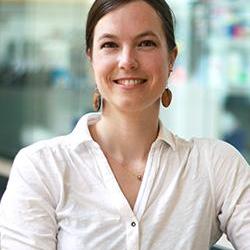Biography
I did my PhD research in the Theoretical Biology and Bioinformatics group at Utrecht University. There, I studied the evolution of segment patterning in animal embryos by making computational models in which the development of segments could evolve. This sparked my interest in general patterns of evolution of development, so I moved to the group of Isaac Salazar-Ciudad at the University of Helsinki to study how the regulatory mechanisms of tissue morphogenesis evolve under conservative selection. For a second postdoc, I joined the Origins Center to study the origins of embryonic development itself, when multicellular life evolves from a unicellular ancestor. I developed models of migrating cells which start grouping together to reach resources and compete with each other, inadvertently resulting in developmental patterns.
Research
At the SLCU I work on these research interests by studying the evolution of plant organs, in particular the apical stem cell niche. I hope to find general principles of evolution that are shared between plants and animals, as well as interesting and informative differences. In both cases, embryonic development generates a complete multicellular organism from a single, fertilized egg cell; it's a program which is (mostly) encoded in the genome, but then requires coordinated interactions between several different levels of organisation. Because of this complex mapping from the genotype to the phenotype, mutations can have wildly different effects on the developmental process, ranging from no effect to lethality. We therefore need to understand how development influences the effects of mutations and how mutations in turn alter the developmental program, to understand the evolution of multicellular organisms as a whole. The time scales of these evolutionary processes are vast, and therefore difficult to study in the lab alone. I therefore construct computer models in which I simulate an evolving population of plants which have to grow and develop. When a successful plant reproduces, its offspring will inherit their genome, with mutations. In this way, I can simulate thousands of years of evolution in days or weeks, and store a perfect fossil record of all the changes in the developmental program. This allows me to study in detail how, over evolutionary time, the accumulation of mutations leads to new developmental programs that make new organs. By switching up the starting conditions
Publications
RMA Vroomans, ES Colizzi (2023) Evolution of selfish multicellularity: collective organisation of individual spatio-temporal regulatory strategies. BMC Eco Evo. https://doi.org/10.1186/s12862-023-02133-x
ES Colizzi, B van Dijk, RMH Merks, DE Rozen, RMA Vroomans (2023) Evolution of genome fragility enables microbial division of labor. Mol Syst Biol. https://doi.org/10.15252/msb.202211353
ES Colizzi, P Hogeweg, RMA Vroomans (2022) Modelling the evolution of novelty: a review. Essays Biochem
https://doi.org/10.1042/EBC20220069
RMA Vroomans, P Hogeweg, KHWJ Ten Tusscher (2018) Around the clock: gradient shape and noise impact the evolution of oscillatory segmentation dynamics. EvoDevo. https://doi.org/10.1186/s13227-018-0113-2

